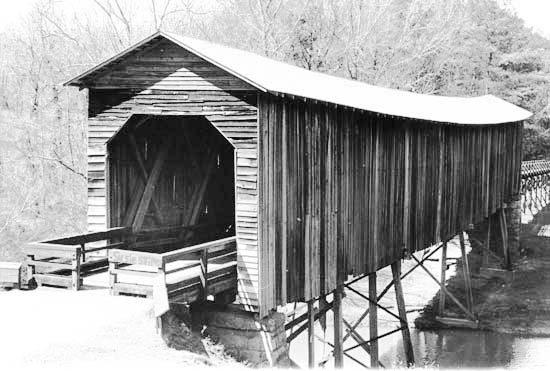 |
| Bridge |
| South Carolina Department of Archives and History |
| National Register Properties in South Carolina Long Cane Covered Bridge, McCormick County (Troy vicinity) |
 |
| Bridge |
Long Cane Covered Bridge is significant as one of three remaining covered bridges in South Carolina. The bridge was constructed in the summer of 1892 by Y.P. Reagan to replace an earlier bridge that had been washed away in January of that same year. Long Cane was also known as Bradley’s Bridge because it was built in close proximity to John Bradley’s mill. The bridge is a covered bridge constructed in the Howe style, a type of construction which introduced iron rods into the bridge trusses. This design proved to be both popular and influential and served as a means of transition from wooden bridges to those built of iron and steel. The bridge is 30 feet high and spans 163 feet over Long Cane Creek. It rests on two stone abutments with four supporting piers in the creek bed. The bridge consists of a series of 13 boxed “X” panel trusses in which iron turn-buckles were added for stability. The vertical board and batten siding used to cover these panel trusses is unpainted and irregularly cut. The portals are covered with unpainted wooden clapboards; a tin roof covers the bridge. Listed in the National Register December 22, 1977. The Long Cane Covered Bridge has since burned. Removed from the National Register August 31, 1979.
View the complete text of the nomination form for this National Register property.
Most National Register properties are privately owned and are not open to the public. The privacy of owners should be respected. Not all properties retain the same integrity as when originally documented and listed in the National Register due to changes and modifications over time.
Images and texts on these pages are intended for research or educational use. Please read our statement on use and reproduction for further information on how to obtain a photocopy or how to cite an item.
Images provided by the South Carolina Department of Archives and History.